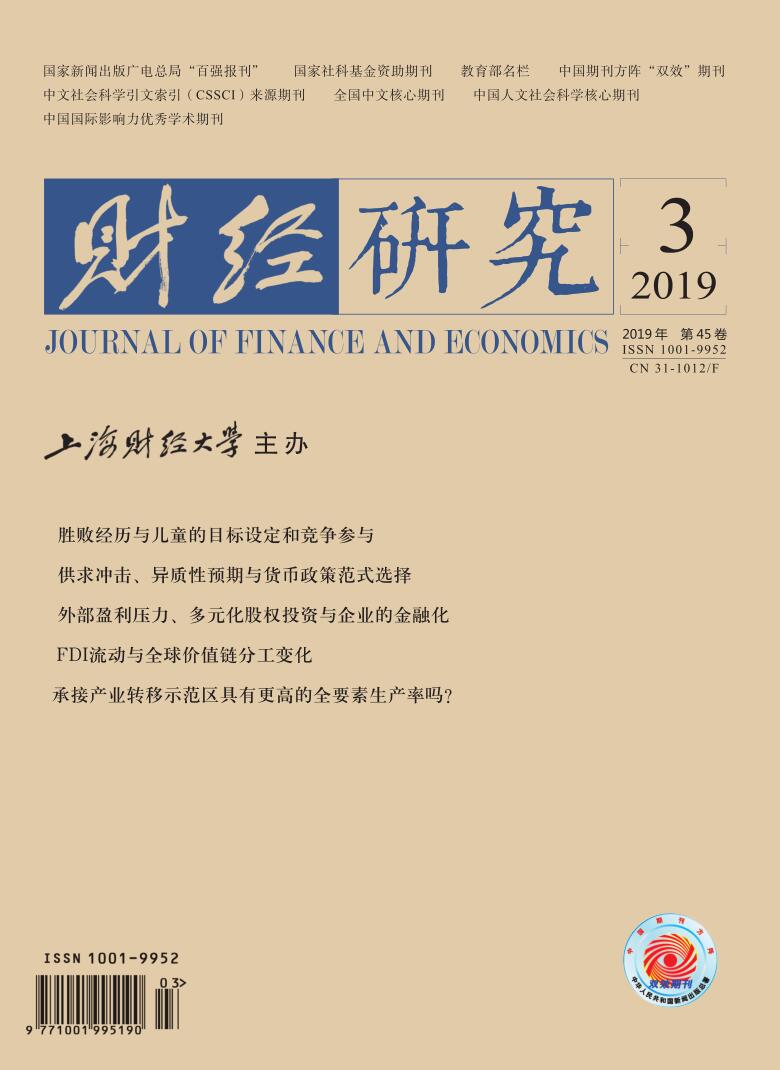Since the 2008 international financial crisis, many countries have returned to the discretionary paradigm in macroeconomic regulation.
 / Journals / Journal of Finance and Economics
/ Journals / Journal of Finance and EconomicsJournal of Finance and Economics
LiuYuanchun, Editor-in-Chief
ZhengChunrong, Vice Executive Editor-in-Chief
YaoLan BaoXiaohua HuangJun, Vice Editor-in-Chief
Shocks of Supply and Demand,Idiosyncratic Expectations and the Choice of Monetary Policy Paradigms
Journal of Finance and Economics Vol. 45, Issue 03, pp. 47 - 59 (2019) DOI:10.16538/j.cnki.jfe.2019.03.004
Summary
References
Summary
[1]Bian Z C, Gao J C. Adaptive learning, macroeconomic expectation and the optimal monetary policy in China[J]. Economic Research Journal, 2014, (4): 32-46. (In Chinese)
[2]Bian Z C, Gao J C. Designing the monetary policy system from the perspective of macroscopic stability[J]. Journal of Finance and Economics, 2015, (2): 3-14. (In Chinese)
[3]Bian Z C, Zhang Y. The information disclosure of central bank, actual intervention and inflation expectation management[J]. Economic Research Journal, 2012, (12): 15-28. (In Chinese)
[4]Chen Y B. New ideas of the 13th Five-Year Plan outline about macro-control[N]. Guangming Daily, 2016. (In Chinese)
[5]Cheng J L. Monetary policy under heterogeneous expectations: Discretion or commitment[J]. Studies of International Finance, 2010, (3): 18-26. (In Chinese)
[6]Fan C L, Gao J C. Adaptive learning and China’s inflation disequilibrium[J]. Economic Research Journal, 2016, (9): 17-28. (In Chinese)
[7]Guo Y M, Chen W Z, Chen Y B. The decreasing effectiveness of China’s monetary policy and expectation management[J]. Economic Research Journal, 2016, (1): 28-41. (In Chinese)
[8]Guo Y M, Zhou X. Central bank communication, adaptive learning and monetary policy effectiveness[J]. Economic Research Journal, 2018, (4): 77-91. (In Chinese)
[9]Liu F L, Lu X, Yi X. A study on the characteristics of mean convergence among China’s intersectoral inflation: Construction of new methods and empirical analysis[J]. Management World, 2012, (9): 36-48. (In Chinese)
[10]Ma Y, Chen Y L. Economic openness and the effectiveness of monetary policy: Microeconomic foundations and empirical analysis[J]. Economic Research Journal, 2014, (3): 35-46. (In Chinese)
[11]Walsh C E. Monetary theory and policy[M]. Peng X Y, Zeng G (Translated). Shanghai: Gezhi Press, Shanghai Sanlian Bookstore, Shanghai Peopl’s publishing Press, 2012. (In Chinese)
[12]Wang G J, Tian G Q. Financial shocks and Chinese business cycles[J]. Economic Research Journal, 2014, (3): 20-34. (In Chinese)
[13]Xiao Z Y, Chen Y B. A research on China’s inflation expectation: Survey data method[J]. Journal of Finance Research, 2004, (11): 1-18. (In Chinese)
[14]Xu Z W, Fan H C, Xue H X. Public expectation, money supply and inflation dynamics[J]. China Economic Quarterly, 2015, (4): 1211-1234. (In Chinese)
[15]Yang Y Y, Zhang X L, Yu J P. Heterogeneous expectations, macroeconomic fluctuations and the effectiveness of monetary policy: Double checks from quantitative and price tools[J]. Studies of International Finance, 2017, (9): 25-34. (In Chinese)
[16]Zhang B. The properties of inflation expectations and their impact on inflation in China[J]. Journal of Financial Research, 2009, (9): 40-54. (In Chinese)
[17]Blanchard O J, Fischer S. Lectures on macroeconomics[M]. Cambridge MA: The MIT Press, 1989.
[18]Branch W A. The theory of rationally heterogeneous expectations: Evidence from survey data on inflation expectations[J]. The Economic Journal, 2004, 114(497): 592-621. DOI:10.1111/j.1468-0297.2004.00233.x
[19]Branch W A, Evans G W. Monetary policy and heterogeneous expectations[J]. Economic Theory, 2011, 47(2-3): 365-393. DOI:10.1007/s00199-010-0539-9
[20]Calvo G A. Staggered prices in a utility-maximizing framework[J]. Journal of Monetary Economics, 1983, 12(3): 383-398. DOI:10.1016/0304-3932(83)90060-0
[21]Cowan K, Filardo A, García P, et al. It in financially stable economies: Has it been flexible enough?[R]. Documentos de Trabajo, 2009.
[22]Evans G W, Honkapohja S. Monetary policy, expectations and commitment[J]. The Scandinavian Journal of Economics, 2006, 108(1): 15-38. DOI:10.1111/sjoe.2006.108.issue-1
[23]Gelain P, Lansing K J, Mendicino C. House prices, credit growth, and excess volatility: Implications for monetary and macroprudential policy[R]. Norges Bank Working Paper, 2013.
[24]Hommes C H, Massaro D, Weber M. Monetary policy under behavioral expectations: Theory and experiment[R]. Bank of Lithuania Working Paper, 2015.
[25]Huang K X D, Liu Z, Zha T. Learning, adaptive expectations and technology shocks[J]. The Economic Journal, 2009, 119(536): 377-405. DOI:10.1111/j.1468-0297.2008.02238.x
[26]Lucas Jr R E. Expectations and the neutrality of money[J]. Journal of Economic Theory, 1972, 4(2): 103-124. DOI:10.1016/0022-0531(72)90142-1
[27]McCallum B T, Nelson E. Timeless perspectives vs. discretionary monetary policy in forward-looking models[R]. NBER Working Paper No.7915, 2000.
[28]Muth J F. Rational expectations and the theory of price movements[J]. Econometrica, 1961, 29(3): 315-335. DOI:10.2307/1909635
[29]Orphanides A, Williams J C. The decline of activist stabilization policy: Natural rate misperceptions, learning, and expectations[J]. Journal of Economic Dynamics and Control, 2005, 29(11): 1927-1950. DOI:10.1016/j.jedc.2005.06.004
[30]Pfajfar D, Zakelj B. Inflation expectations and monetary policy design: Evidence from the laboratory[R]. CentER Discussion Paper Series No.2011-091, 2011.
[31]Sargent T J, Wallace N. Rational expectations and the theory of economic policy[J]. Journal of Monetary Economics, 1976, 2(2): 169-183. DOI:10.1016/0304-3932(76)90032-5
[32]Sargent T J. Bounded rationality in macroeconomics: The Arne Ryde memorial lectures[M]. Clarendon Press, 1993.
[33]Svensson L E O. Inflation targeting as a monetary policy rule[J]. Journal of Monetary Economics, 1999, 43(3): 607-654. DOI:10.1016/S0304-3932(99)00007-0
[34]Taylor J B. The role of policy in the great recession and the weak recovery[J]. American Economic Review, 2014, 104(5): 61-66. DOI:10.1257/aer.104.5.61
[35]Woodford M. Optimal interest-rate smoothing[J]. The Review of Economic Studies, 2003, 70(4): 861-886. DOI:10.1111/1467-937X.00270
[36] Woodford M. Inflation targeting and financial stability[R]. NBER Working Paper No.17967, 2012.
Cite this article
Gao Jiechao, Yang Yuanyuan, Fan Conglai. Shocks of Supply and Demand,Idiosyncratic Expectations and the Choice of Monetary Policy Paradigms[J]. Journal of Finance and Economics, 2019, 45(3): 47-59.
Export Citations as:
For
ISSUE COVER
RELATED ARTICLES




 , 2
, 2 6440
6440  10259
10259

